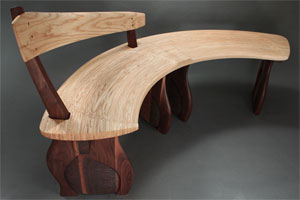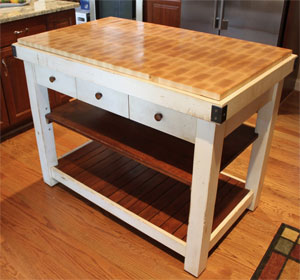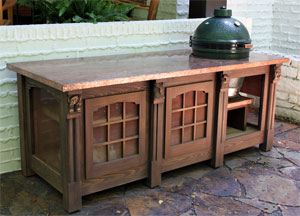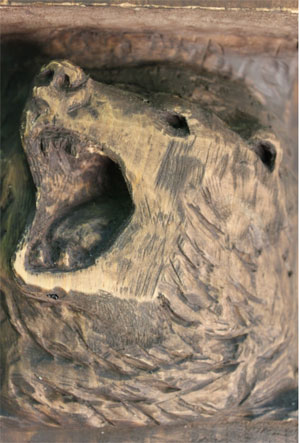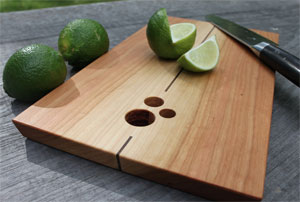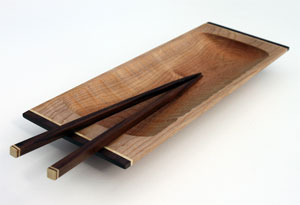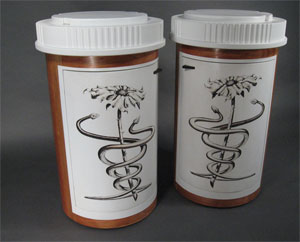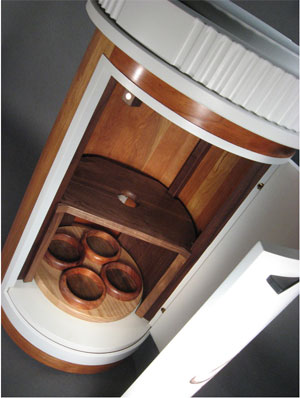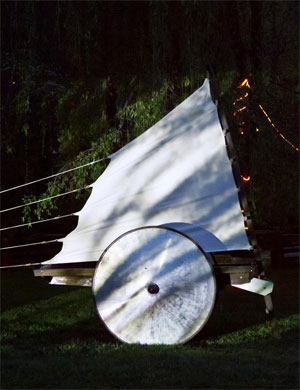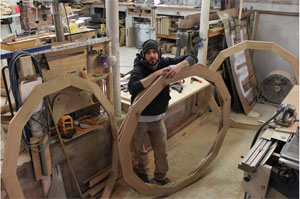
When Chris Perryman was a third grader, while playing hide-and-seek behind a neighbor’s wood pile, he happened to notice a large piece of pine and thought, “That’s an awesome piece of wood! I’m gonna do something with it.” One red-painted soapbox derby car with lawnmower tires later, you’d think the path was set in stone for a future woodworker, right?
Not so fast. Although there are three generations of woodworkers in his mother’s family, they lived two hours away from his childhood home. “It was always around me, but not in my face,” Chris said. When he went to the University of North Carolina at Asheville to pursue an art degree, “I wasn’t interested in wood at all. It didn’t cross my mind.The fine arts program did not celebrate wood as a viable medium.”
What happened? He got a job his sophomore year delivering furniture. Although “it was production furniture I was schlepping up hills,” Chris said, the job gave him exposure to luxury housing, where he observed the world of fine custom furniture. Through his friendship with the company’s owners, it also gave him access to a shop: “They gave me a key, so I could come in at night and get away from the studio at school, which could get crowded.”
Working for the furniture company sometimes meant doing repairs to furniture — replacing legs, etc. — and, with the shop access, Chris says he “basically taught myself to make furniture by taking apart furniture. I could flip a sofa table on its back, and I didn’t understand the tools needed to do something, but I could see how to do it.”
A lot of construction and renovation was going on in downtown Asheville at the time; there were also several locally owned businesses that were willing to showcase his work in their boutiques. Chris eventually paid for his last semester of school by selling a large pine armoire built from construction materials.
“I began putting two and two together, and could see how to make woodworking financially viable — rather than conceptual art,” Chris said. These days, his one-man shop is the Goldsplinter Woodworking Studio in Asheville.
For the last few years, Chris has been getting some custom commissions through interior designers. Among these was an outdoor grilling table built for a residence designed by William Waldo Dodge. Dodge, one of the architects involved with building the Vanderbilts’ Biltmore mansion, had designed the house for a woodworker friend of his. “He set beams into place for the guy to hand carve his own window sills and little gargoyles,” Chris said, and the grilling table played off of that. The front of the table is a reimagined facade of the house, on which Chris carved two gargoyles and two animals: a bear and an owl. “I made it like a meat-eater’s table: all carnivores,” he explained.
“The project was fun and paid for the Foredom® Carver I bought to carve it,” Chris said, and added, “Cypress is a weird wood to carve, but it holds up well.”
In general, Chris said, he likes most kinds of domestic hardwood, as well as the occasional sapele and mahogany. “Where I live, you can hardly see the sun for the trees around us. There are a ton of woodworkers, and a ton of sawyers,” which means that his choices of wood largely focus on the color palette. Chris does admit, however, that he also has “a soft spot for woods with a lot of tannic acid. It ebonizes real well. I’ll dissolve bits of steel wool in vinegar until it’s a liquid and spray it on. I get lots of ebonization tricks out of cherry or oak.”
Many of the cutting boards Chris makes are from wood from a cherry tree that once hung over his bedroom window but had to come down after storm damage. “The shade trees from somebody’s house usually have so much more character,” he said. “The richness of this cherry is outstanding.”
The cutting boards are part of a relatively new endeavor for Chris, part of a new line of kitchen pieces. As a custom furniture maker, he said, he is “always building prototypes. There’s nothing that I’ve built that I couldn’t do it faster and better the next time, but that doesn’t happen because it’s all custom. I have learned that it’s important to have at least something to rely on, where you take out all the bottlenecks of a process and do something really fast, really efficiently; something for stability.”
While Chris says he loves working with people as a custom furniture maker, “We get lured in by the creative jollies of it all and think we’ll get to a plateau where you’re booked with the $10,000 dining chair you make, but there are windows in there where you aren’t going to see a dollar from that. You have to have some sort of bread and butter coming in from somewhere. If you don’t, you will get hungry.”
The kitchen cutting boards and serving vessels are meant to be that bread and butter for Chris. They also tie in to another of his interests. “Usually on Sundays, if I can bring myself not to turn the lights on in the shop, and if I’ve planned ahead and gone to the farmer’s market on Saturday, I’ll take the chicken out of the salt brine and go to town. It’s fun to play,” he said.
He also tests his own products, such as with some cherry plates he made. “I’m just loving them. I didn’t realize how accustomed you get to the sound of the stainless steel fork coming off a ceramic glazed plate.” With the wooden plates, “It changes things,” he said.
All of Chris’s pieces of furniture “have some sort of hook to them,” he said. For example, his pill bottle-shaped Caduceus Cabinets liquor cabinets that convert into barstools “are basically a protest against us not having realistic access to health care in the United States. I was particularly frustrated because I played with solvent all day and couldn’t afford access to health care at the time.”
His Foot File cabinet came from some experiments with feet (as in the bodily appendages) as feet (as in for furniture). He’d done a previous experiment where, unable to decide what to use for feet on a coffee table, he decided just to go with “feet,” took his shoe off and used his food as a rough model for a sculpture on the band saw. The Foot File itself has two pairs of feet, and “they’re in a position that something’s happening inside that cabinet, but we don’t know what.
And, his rickshaw-like Excursus Contraption is “built out of a white oak I grew up under. It’s almost like a woodworker’s self-portrait, kind of.”
Such personal connections to wood tie in to what Chris describes as his greater goal: “to put meaning and significance back into the objects of our lives. In days gone by, objects in the house had so much more meaning, because they were more difficult to get. The stuff in our lives is really without meaning any more, and poorly made on top of that.”
Using wood with a personal connection to the maker or the consumer provides “significance in where the materials are from.” With that, “or a great story,” Chris said, “the value of the custom maker will endure to some extent, because you can provide that.”
